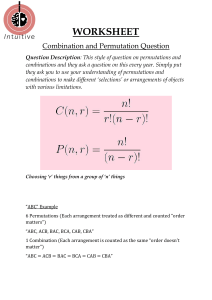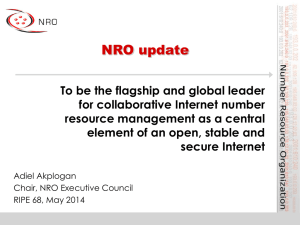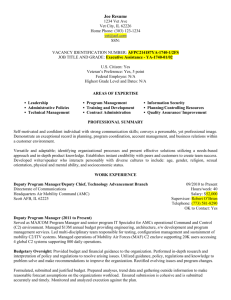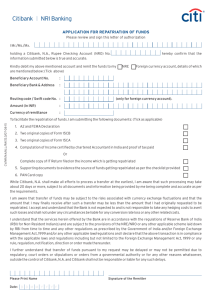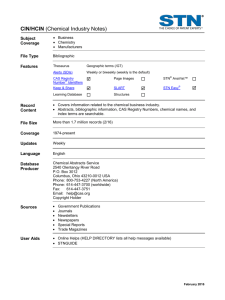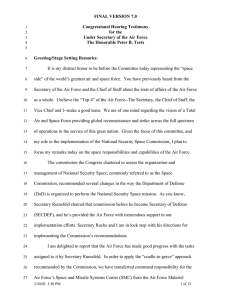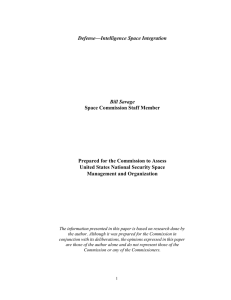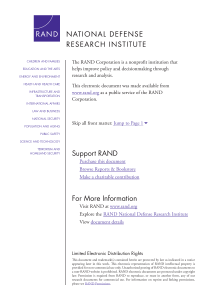A DISCUSSION OF SYSTEMS ENGINEERING Dr Robert H. Latiff Maj Gen, USAF(Ret)
advertisement
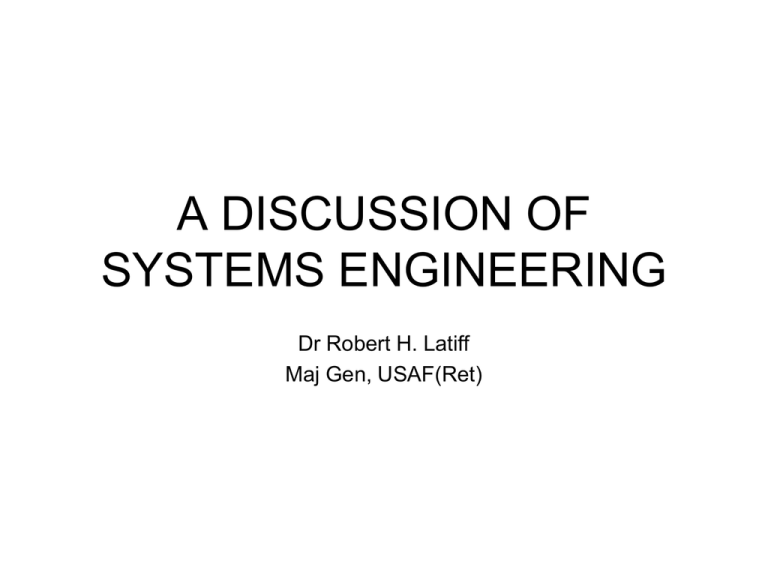
A DISCUSSION OF SYSTEMS ENGINEERING Dr Robert H. Latiff Maj Gen, USAF(Ret) The End Result – 19 Oct 2005 TOPICS • • • • • • Personal Background Some History and Examples Levels of Systems Engineering NRO Future Direction The Importance of Risk Analysis Individual Engineering Disciplines Personal Background • • • • • • Strategic Defense Initiative Cheyenne Mountain Upgrade Airspace Management Systems Joint STARS NRO Advanced Systems and Technology NRO Systems Engineering Historical Underpinnings • • • • • • SAGE ICBM Navy Nuclear Program AT&T Telephony MIT Rad Lab Manhattan Project • Note: Recommended reading: Rescuing Prometheus – by Thomas P. Hughes Some Notable Systems Engineering Failures Systems Engineering Successes Representative Examples • Cheyenne Mountain – One Version, Multiple Customers • Air, missile, space, Comm • NORAD, STRAT,USSPACE, AFSPACE • Joint STARS – One Customer, Multiple Versions • Block Upgrade Plan • Electro Optical Space System-Generic – Inadequate Analysis of Requirements Change What Is It? Selectively Chosen To Make My Point • INCOSE – Tradeoff analysis and integration between system elements… much more of an engineering focus than a management discipline • Air Force SMC -..tradeoff, assessments and decisions…ultimately involve all specialty engineers…SE is inextricably linked to program management • NRO – SE is a process used to develop requirements and integrate technical efforts. SE translates mission and operational needs, balanced by technical maturity as well as risk… • SAIC – SE integrates all the disciplines and specialty groups into a team effort forming a structured development process…considers both the business and technical needs of all customers Systems Engineering VEE Model Validation, Deployment & Employment Mission itio n Component Requirements & Design Subsystem Levels Component Level Subsystem Integration& Verification Component Integration& Verification Unit Level Development, Procurement, Assembly Build PROGRAM MATURITY rati o pos com Subsystem Requirements & Design n System Integration & Verification System Level Inte g System Requirements & Architecture De PROGRAM DETAIL User Needs & Concept of Operations Systems Engineering in the Intelligence Community • Director of National Intelligence – Space, Human, Airborne • National Reconnaissance Office – EO, Signals, Communications • NRO Tower (USAF PEO Equivalent) – EO1, EO2 or SI1, SI2 • NRO Program – Phenomenology1, phenomenology2 • NRO System • etc NRO Strategic Framework • Single Integrated Architecture – Multi-discipline, cross sensor, tasking, fusing – Performance measured at architectural level • Ground – Equal priority with space – Create information, not just data; add value • Rapid Response – Develop and deploy new quick reaction sensors and platforms – Same priority and emphasis as big acquisitions NRO Architectural Considerations • • • • • • • • • • • • Air and Space Integration Temporal, frequency, spectral coverage Point and large area On demand, all weather Advanced tech for rapid, flexible access Geolocation accuracy Sophisticated denial and deception Industrial base Emerging threats Continuity of operations Access to space Space and terrestrial communication capabilities Key Points • Relationships among Engineering Disciplines, Systems Engineering, and Program Management • Relationship between Systems Engineering and Advanced R&D/Innovation • It’s all about RISK RISK RISK • Air Force and NRO Testing Studies – Inadequate parts testing – Strongly Correlated to Acquisition Reform – Increased on-orbit failures • Mission impact • Mission failure To Engineer Is Human Henry Petroski Author The Logic of Failure • We find a tendency under time pressure to apply overdoses of established measures. We find an inability to think in terms of non-linear networks of causation, an inability, that is, to properly assess the side effects and repercussions of one’s behavior. We find an inadequate understanding of exponential development, an inability to see that a process that develops exponentially will, once it is begun, race to its conclusion with incredible speed. These are all failures of cognition. Dietrich Dorner, The Logic of Failure

